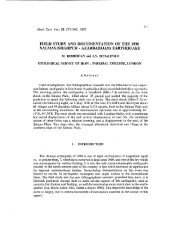PDF COPY - Manuel berberian
PDF COPY - Manuel berberian
PDF COPY - Manuel berberian
You also want an ePaper? Increase the reach of your titles
YUMPU automatically turns print PDFs into web optimized ePapers that Google loves.
FOREWORDby Reza Assefi, Managing Director, Geological and Mining Survey of IranIn 1976, the Geological Survey of Iran published the first comprehensive studyof Iranian seismotectonics and earthquake faults. Based upon the researches of Mr.<strong>Manuel</strong> Berberian, our relevant expert in Tectonics and Seismotectonics, it wasentitled "Contributions to the Seismotectonics of Iran (Part II), and was publishedin commemoration of the fiftieth anniversary of the Pahlavi Dynasty.In that volume, full seismic data were given for the earthquakes which occurredin Iran from the 4th Century B.C. to March 1976, together with magnitude, focaldepth, and their relation to our present knowledge of faults and tectonic phenomena.For the first time, the Iranian faults were divided into various categories: three basedupon genetic classification, and three based upon recency of movement. The pertienentdata were presented on the accompanying "Seismotectonic Map of Iran".These reports and maps were received with enthusiasm by earth scientists workingon the many problems concerned with the seismotectonics of Iran. Design engineersinvolved in construction projects in Iran found the Seismotectonic Map both valuableand convenient for practical use. At the same time, however, they suggested that Mr.Berberian’s expertise might be further utilised to prepare a Seismic Risk Map of Iranon the basis of the earlier published volume, and more recent research.Acknowledging the justice of these observations, and the necessity of fulfillingthe engineer’s needs, the Geological and Mining Survey of Iran requested Mr. Berberianto prepare such a map as a matter of urgency. As with the previous volume, the timeavailable was limited, and Mr. Berberian devoted both his official working hours andhis spare time unstintingly to meet his deadline, whilst not allowing the high standardof his work to fall.On this Preliminary Seismic Risk Map of Iran, the country has been divided intofour different zones according to seismic risk. These zones will facilitate the builder’stask in choosing the correct anti-seismic code, and in selecting the most suitable constructionmaterials. The preparation of this Seismic Risk Map was the first step madeby the Geological and Mining Survey of Iran towards compiling a definitive versionat a future date. It is hoped that this step will encourage experts in the relevant fieldsto contribute such knowledge as they may have, for an accurate and completeSeismic Risk Map would be of inestimable value for the development of Iran.







